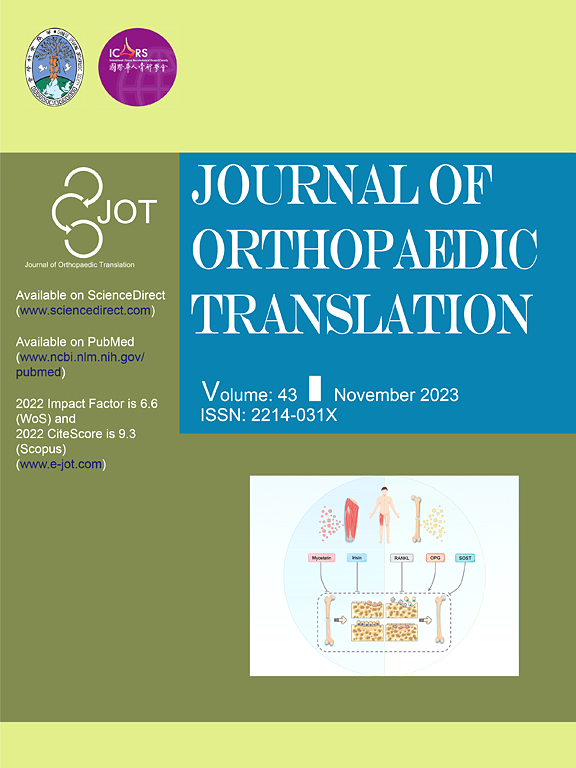肌肉骨骼系统老化中的机械效应:分子信号和空间尺度的改变
IF 5.9
1区 医学
Q1 ORTHOPEDICS
引用次数: 0
摘要
肌肉骨骼系统是人体的主要承重结构,在机械传导中起着至关重要的作用,机械传导是一个由机械感觉、机械传导和机械效应组成的过程。衰老导致机械敏感细胞感知机械刺激的能力丧失、转导通路中断、SASP和脂肪积累。在介观水平,骨、软骨和肌肉分化下降,脂肪生成增加,导致细胞外基质和结构老化,最终表现为宏观的肌肉骨骼变性。本文从力学生物学角度探讨衰老过程中细胞间串扰和机械转导的改变,为骨老化和骨质疏松症的潜在治疗靶点提供见解。介绍了介观尺度的定义和经介观移植治疗作为骨折治疗、术后康复和骨再生的新策略,为未来肌肉骨骼研究提供了创新方向。本文从力学生物学的角度系统综述了衰老对肌肉骨骼系统的影响,从微观的分子信号传导到宏观的空间结构改变,并提出了补充AO治疗原理的新策略,优化制动,肿瘤转移和负重的新见解,以及经介系膜移植治疗的新策略。这些见解将有助于优化老年人脆性骨折的管理,探索治疗衰老肌肉骨骼系统疾病的创新疗法,并促进骨科领域的综合疗法和精准医学的发展。本文章由计算机程序翻译,如有差异,请以英文原文为准。

Mechanical effects in aging of the musculoskeletal system: Molecular signaling and spatial scale alterations
The musculoskeletal system, the primary load-bearing structure of the human body, plays a crucial role in mechanotransduction, a process comprising mechanosensation, mechanotransduction, and mechanical effect. Aging leads to loss of ability of mechanosensitive cells to sense mechanical stimuli, disruption of transduction pathways, SASP and adiposity accumulation. At the mesoscopic level, bone, cartilage, and muscle differentiation decline, while adipogenesis increases, leading to extracellular matrix and structural aging, ultimately manifesting as macroscopic musculoskeletal degeneration. This review explores intercellular crosstalk and mechanotransduction alterations in aging from a mechanobiological perspective, providing insights into potential therapeutic targets for bone aging and osteoporosis. It also introduces the mesoscopic scale definition and trans mesoscopic transplantation therapy as novel strategies for fracture treatment, postoperative rehabilitation, and bone regeneration, offering innovative directions for future musculoskeletal research.
The translational potential of this article
This article systematically reviews the effects of aging on the musculoskeletal system from a mechanobiological viewpoint, covering from microscopic molecular signaling to macroscopic spatial structural alterations, and proposes new strategies to complement the principles of AO therapy, optimization of braking, new insights into tumor metastasis and weight-bearing, and a new strategy for trans mesoscopic transplantation therapy. These insights will contribute to optimizing the management of geriatric fragility fractures in the elderly, exploring innovative therapies for the treatment of diseases of the aging musculoskeletal system, and facilitating the development of integrative therapies and precision medicine in the field of orthopaedics.
求助全文
通过发布文献求助,成功后即可免费获取论文全文。
去求助
来源期刊

Journal of Orthopaedic Translation
Medicine-Orthopedics and Sports Medicine
CiteScore
11.80
自引率
13.60%
发文量
91
审稿时长
29 days
期刊介绍:
The Journal of Orthopaedic Translation (JOT) is the official peer-reviewed, open access journal of the Chinese Speaking Orthopaedic Society (CSOS) and the International Chinese Musculoskeletal Research Society (ICMRS). It is published quarterly, in January, April, July and October, by Elsevier.
 求助内容:
求助内容: 应助结果提醒方式:
应助结果提醒方式:


